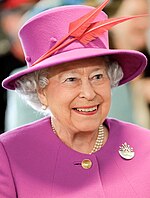Portal:Monarchy/Featured article/2
The monarchy of the United Kingdom is the constitutional monarchy of the United Kingdom, its dependencies and its overseas territories. The current monarch and head of state, Queen Elizabeth II, ascended the throne on the death of her father, King George VI, on 6 February 1952. The monarch and his or her immediate family undertake various official, ceremonial, diplomatic and representational duties. As the monarchy is constitutional, the monarch is limited to non-partisan functions such as bestowing honours and appointing the Prime Minister. The monarch is commander-in-chief of the British Armed Forces. Though the ultimate formal executive authority over the government of the United Kingdom is still by and through the monarch's royal prerogative, these powers may only be used according to laws enacted in Parliament and, in practice, within the constraints of convention and precedent.The British monarchy traces its origins from the petty kingdoms of early medieval Scotland and Anglo-Saxon England, which consolidated into the kingdoms of England and Scotland by the 10th century AD. In 1066, the last crowned Anglo-Saxon monarch, Harold Godwinson, was defeated and killed during the Norman conquest of England and the English monarchy passed to the Normans' victorious leader, William the Conqueror, and his descendants.

